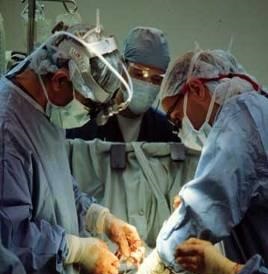The augmented reality wearable technology was used to assist with the complex medical procedure.
Despite the fact that Google Glass has been falling out of the spotlight over the last while, the device has managed to make headlines once again as cardiologists have now used the wearable technology to assist them in completing a surgical procedure to unblock the coronary artery of a 49 year old male patient.
A custom app was created for the purposes of this procedure and the augmented reality headset displayed the 3D assistance.
The Google Glass app was created to offer the surgeons a 3 reconstruction of the artery, which they could view through the headset throughout the length of the procedure. This made it possible for the physicians to more effectively guide a catheter to the area with the clog. Using a catheter was used to send a stent or balloon into a clogged area is a common method of treating a blocked coronary artery. It is a procedure that is called a catheter-based percutaneous coronary intervention (PCI). That said, there are risks involved with this type of surgery, as one of the most challenging components of the process is to image the artery.
Google Glass made it easier for the doctors to use imaging and to view it in a way that could help to guide them.
 Computed tomography angiography (CTA) imaging techniques were used to view the patient’s specific blockage. The augmented reality headset then used the custom mobile app to display the patient’s own unique artery and blockage within the field of vision of the physician. This way, the doctor could visualize the patient’s own coronary vessel as the catheter was used for unblocking the area. In this specific surgery, there were two drug-eluting stents that were successfully implanted into the patient.
Computed tomography angiography (CTA) imaging techniques were used to view the patient’s specific blockage. The augmented reality headset then used the custom mobile app to display the patient’s own unique artery and blockage within the field of vision of the physician. This way, the doctor could visualize the patient’s own coronary vessel as the catheter was used for unblocking the area. In this specific surgery, there were two drug-eluting stents that were successfully implanted into the patient.
Using this strategy with Google Glass, it means that the same CTA images become much more usable and practical for doctors while they conduct the procedure as they can view them at the same time that they are inserting the catheter in order to provide them with continual customized guidance.
New wearables from a U.K. mobile tech firm are being created to help in this specific purpose.
A company based in the United Kingdom called Mobetrics, which was founded last year and specializes in smart and wearable technology, has now received the funding that it requires to start the development of a new form of wearables that are meant for nuclear decommissioning.
The new “Second Sight” system is going to use a combination of existing tech, Google Glass and Android.
The wearable technology will work by measuring and analyzing the body of workers in nuclear decommissioning projects. This will help to provide a view in real-time of what their suit temperatures, heart rates and radiation dose readings are at any given moment. The purpose of monitoring and tracking this information is to help in improving the safety level during stressful operations. It is also designed to use Google Glass to stream live mages so that workers can obtain additional information and support as needed.
The wearable technology will also offer visual messaging and barcode scanning for additional guidance and info.
 Through these wearables, these workers will be able to obtain the data and technical guidance they require for more accurate, confident and efficient decision making. This helps to ensure that tasks will be completed with the greatest degree of effectiveness and safety possible.
Through these wearables, these workers will be able to obtain the data and technical guidance they require for more accurate, confident and efficient decision making. This helps to ensure that tasks will be completed with the greatest degree of effectiveness and safety possible.
Among the support Mobetrics has received includes that of partners from the University of Manchester, the National Nuclear Laboratory and Sellafield Ltd. According to Nick Whitehead, one of the company’s co-founders, “Mobetrics develops products that use the latest technology and by interacting closely with Sellafield we’ve been able to address the specific and unusual needs of their industry.”
He went on to explain that through the creation of new uses for hardware that is already commercially available, it means that businesses will have access to a whole new range of capabilities that have already been proven and have been deemed reliable.
Second Sight wearable technology also received funding and development from Innovus. This tech will be finding its way into the spotlight this week on November 4 in Manchester at the NDA Supply Chain Event.
 Computed tomography angiography (CTA) imaging techniques were used to view the patient’s specific blockage. The augmented reality headset then used the custom mobile app to display the patient’s own unique artery and blockage within the field of vision of the physician. This way, the doctor could visualize the patient’s own coronary vessel as the catheter was used for unblocking the area. In this specific surgery, there were two drug-eluting stents that were successfully implanted into the patient.
Computed tomography angiography (CTA) imaging techniques were used to view the patient’s specific blockage. The augmented reality headset then used the custom mobile app to display the patient’s own unique artery and blockage within the field of vision of the physician. This way, the doctor could visualize the patient’s own coronary vessel as the catheter was used for unblocking the area. In this specific surgery, there were two drug-eluting stents that were successfully implanted into the patient.
 Through these
Through these 